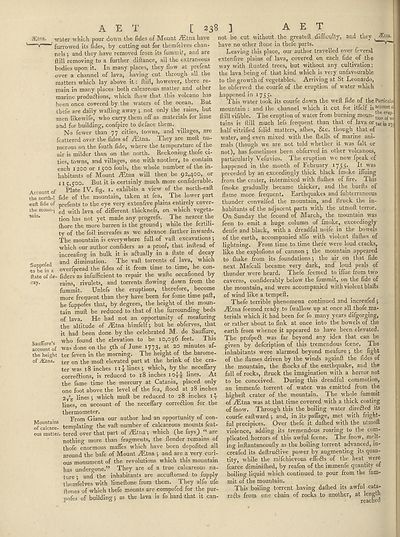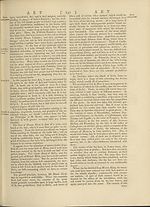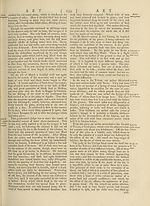Encyclopaedia Britannica, or, a Dictionary of arts, sciences, and miscellaneous literature : enlarged and improved. Illustrated with nearly six hundred engravings > Volume 1, A-AME
(262) Page 238
Download files
Complete book:
Individual page:
Thumbnail gallery: Grid view | List view

A E T
[ 238 ]
A E T
the moun-j
tain
'Etna, water which pour down the fides of Mount jjEtna have
' £urrowed its fides, by cutting out for themfelves chan¬
nels j and they have removed from its fummit, and are
ftill removing to a further diftance, all the extraneous
bodies upon it. In many places, they flow at prefent
over a channel of lava, having cut through all the
matters which lay above it : ftill, however, there re¬
main in many places both calcareous matter and other
marine productions, which ftiow that this volcano has
been once covered by the waters of the ocean. But
thefe are daily wafting away ; not only the rains, but
men likewife, who carry them off as materials for lime
and for building, confpire to detace them.
No fewer than 'y'j cities, towns, and villages, are
fcattered over the fides of y^tna. They are molt nu¬
merous on the fouth fide, where the temperature of the
air is milder than on the north. Reckoning thofe ci¬
ties, towns, and villages, one with another, to contain
each 1200 or 1500 fouls, the whole number of the in¬
habitants of Mount yEtna will then be 92,400, or
115 500 But it is certainly much more confiderable.
Accol,„t of Plate IV. fig. .. exhibits a view of the north-eaft
the north-! fide of the mountain, taken at fea.^ The lower part
eaft fide of prefents to the eye very extenfive plains entirely cover-
rh* moun-. jaya 0f different thicknefs, on which vegeta¬
tion has not yet made any progrefs. The nearer the
fhore the more barren is the ground j while the fertili¬
ty of the foil increafes as we advance farther inwards.
The mountain is everywhere full of vaft excavations }
which our author confiders as a proof, that inftead of
increafing in bulk it is aCtually in a ftate of decay
and diminution. The vaft torrents of lava, which
overfpread the fides of it from time to time, he con¬
fiders as infufficient to repair the wafte occafioned by
rains, rivulets, and torrents flowing down from the
fummit. Unlefs the eruptions, therefore, become
more frequent than they have been for fome time paft,
he fuppofes that, by degrees, the height of the moun¬
tain muft be reduced to that of the furrounding beds
of lava. He had not an opportunity of meafuring
the altitude of iEtna himfelf; but he obferves, that
it had been done by the celebrated M. de Sauffure,
who found the elevation to be 10,036 feet. ihis
was done on the 3th of June 1773’ minutes af¬
ter feven in the morning. The height of the barome¬
ter on the moft elevated part at the brink of the cra¬
ter was 18 inches 11^ lines ; which, by the neceffary
corre&ions, is reduced to 18 inches lo^f lines. At
the fame time the mercury at Catania, placed only
one foot above the level of the fea, flood at 28 inches
2rs lines-, which muft be reduced to 28 inches
lines, on account of the neceffary corre&ion for the
thermometer.
From Giana our author had an opportunity of con-
m templating the vaft number of calcareous mounts fcat-
ous matter, tered over that part of yEtna which (he fays_) . are
nothing more than fragments, the flender remains of
thofe enormous maffes which have been depofited all
around the bafe of Mount yEtna ; and are a very curi¬
ous monument of the revolutions which this mountain
has undergone.” They are of a true calcareous na¬
ture and the inhabitants are accuftomed to fupply
themfelves with limeftone from them. They alfo ufe
ftones of which thefe mounts are compofed for the pur-
pofes of building j as the lava is fo hard that it can-
-<Etna.
Suppofed
to be in a
ftate of de
cay.
Sauffbre’s
account of
the height
of yEtna.
Mountains
of calcare-
an
higheft crater of the mountain. The whole fummit
of yEtna was at that time covered with a thick coating
of fnow. Through this the boiling water dire£ted its
courfe eaftward j and, in its paffage, met with fright¬
ful precipices. Over thefe it dallied with the utmoll
violence, adding its tremendous roaring to the com¬
plicated horrors of this awful feene. The fnow, melt¬
ing inftantaneoufly as the boiling torrent advanced, in-
creafed its deftrudlive power by augmenting its quan¬
tity, while the mifehievous effedls of the heat were
fcarce diminiftied, by reafon of the immenfe quantity of
boiling liquid which continued to pour from the fum¬
mit of the mountain.
This boiling torrent having dallied its awful cata¬
racts from one chain of rocks to another, at length
q o r» n P
not be cut without the greateft difficulty, and they
have no other ftone in thefe parts.
Leaving this place, our author travelled over feveral
extenfive plains of lava, covered on each fide of the
way with Hunted trees, but without any cultivation:
the lava being of that kind which is very unfavourable
to the growth of vegetables. Arriving at St Leonardo,
he obferved the courfe of the eruption of water which
happened in 1755*
This water took its courfe down the weft fide of the Particula
mountain : and the channel which it cut for itfelf isaccounto
ftill vifible. The eruption of water from burning moun-
tains is ftill much lefs frequent than that of lava or ter in I7;
half vitrified folid matters, allies, &c. though that of
water, and even mixed with the fliells of marine ani¬
mals (though we are not told whether it was fait or
not), has fometimes been obferved in other volcanoes,
particularly Vefuvius. The eruption we now fpeak of
happened in the month of February 1755. It was
preceded by an exceedingly thick black Imoke iffuing
from the crater, intermixed with Hallies of lire. This
fmoke gradually became thicker, and the burfts of
flame more frequent. Earthquakes and fubterraneous
thunder convulfed the mountain, and ftruck the in¬
habitants of the adjacent parts with the utmoft terror.
On Sunday the fecond of March, the mountain was
feen to emit a huge column of fmoke, exceedingly
denfe and black, with a dreadful noife in the bowels
of the earth, accompanied alfo with violent Hallies of
lightning. From time to time thefe were loud cracks,
like the explofions of cannon 5 the mountain appeared
to ftiake from its foundations the air on that fide
next Mafcali became very dark, and loud peals of
thunder w'ere heard. Thefe feemed to iffue from two
caverns, confiderably below the fummit, on the fide of
the mountain, and were accompanied with violent blafts
of wind like a tempeft.
Thefe terrible phenomena continued and increafed;
iEtna feemed ready to fwallow up at once all thofe ma¬
terials which it had been for fo many years difgorging,
or rather about to fink at once into the bowels of the
earth from whence it appeared to have been elevated.
The profpeft was far beyond any idea that can be
given by defeription of this tremendous feene. The
inhabitants were alarmed beyond meafure ; the fight
of the flames driven by the winds againft the fides of
the mountain, the ftiocks of the earthquake, and the
fall of rocks, ftruck the imagination with a horror not
to be conceived. During this dreadful commotion,
immenfe torrent of water was emitted from the
[ 238 ]
A E T
the moun-j
tain
'Etna, water which pour down the fides of Mount jjEtna have
' £urrowed its fides, by cutting out for themfelves chan¬
nels j and they have removed from its fummit, and are
ftill removing to a further diftance, all the extraneous
bodies upon it. In many places, they flow at prefent
over a channel of lava, having cut through all the
matters which lay above it : ftill, however, there re¬
main in many places both calcareous matter and other
marine productions, which ftiow that this volcano has
been once covered by the waters of the ocean. But
thefe are daily wafting away ; not only the rains, but
men likewife, who carry them off as materials for lime
and for building, confpire to detace them.
No fewer than 'y'j cities, towns, and villages, are
fcattered over the fides of y^tna. They are molt nu¬
merous on the fouth fide, where the temperature of the
air is milder than on the north. Reckoning thofe ci¬
ties, towns, and villages, one with another, to contain
each 1200 or 1500 fouls, the whole number of the in¬
habitants of Mount yEtna will then be 92,400, or
115 500 But it is certainly much more confiderable.
Accol,„t of Plate IV. fig. .. exhibits a view of the north-eaft
the north-! fide of the mountain, taken at fea.^ The lower part
eaft fide of prefents to the eye very extenfive plains entirely cover-
rh* moun-. jaya 0f different thicknefs, on which vegeta¬
tion has not yet made any progrefs. The nearer the
fhore the more barren is the ground j while the fertili¬
ty of the foil increafes as we advance farther inwards.
The mountain is everywhere full of vaft excavations }
which our author confiders as a proof, that inftead of
increafing in bulk it is aCtually in a ftate of decay
and diminution. The vaft torrents of lava, which
overfpread the fides of it from time to time, he con¬
fiders as infufficient to repair the wafte occafioned by
rains, rivulets, and torrents flowing down from the
fummit. Unlefs the eruptions, therefore, become
more frequent than they have been for fome time paft,
he fuppofes that, by degrees, the height of the moun¬
tain muft be reduced to that of the furrounding beds
of lava. He had not an opportunity of meafuring
the altitude of iEtna himfelf; but he obferves, that
it had been done by the celebrated M. de Sauffure,
who found the elevation to be 10,036 feet. ihis
was done on the 3th of June 1773’ minutes af¬
ter feven in the morning. The height of the barome¬
ter on the moft elevated part at the brink of the cra¬
ter was 18 inches 11^ lines ; which, by the neceffary
corre&ions, is reduced to 18 inches lo^f lines. At
the fame time the mercury at Catania, placed only
one foot above the level of the fea, flood at 28 inches
2rs lines-, which muft be reduced to 28 inches
lines, on account of the neceffary corre&ion for the
thermometer.
From Giana our author had an opportunity of con-
m templating the vaft number of calcareous mounts fcat-
ous matter, tered over that part of yEtna which (he fays_) . are
nothing more than fragments, the flender remains of
thofe enormous maffes which have been depofited all
around the bafe of Mount yEtna ; and are a very curi¬
ous monument of the revolutions which this mountain
has undergone.” They are of a true calcareous na¬
ture and the inhabitants are accuftomed to fupply
themfelves with limeftone from them. They alfo ufe
ftones of which thefe mounts are compofed for the pur-
pofes of building j as the lava is fo hard that it can-
-<Etna.
Suppofed
to be in a
ftate of de
cay.
Sauffbre’s
account of
the height
of yEtna.
Mountains
of calcare-
an
higheft crater of the mountain. The whole fummit
of yEtna was at that time covered with a thick coating
of fnow. Through this the boiling water dire£ted its
courfe eaftward j and, in its paffage, met with fright¬
ful precipices. Over thefe it dallied with the utmoll
violence, adding its tremendous roaring to the com¬
plicated horrors of this awful feene. The fnow, melt¬
ing inftantaneoufly as the boiling torrent advanced, in-
creafed its deftrudlive power by augmenting its quan¬
tity, while the mifehievous effedls of the heat were
fcarce diminiftied, by reafon of the immenfe quantity of
boiling liquid which continued to pour from the fum¬
mit of the mountain.
This boiling torrent having dallied its awful cata¬
racts from one chain of rocks to another, at length
q o r» n P
not be cut without the greateft difficulty, and they
have no other ftone in thefe parts.
Leaving this place, our author travelled over feveral
extenfive plains of lava, covered on each fide of the
way with Hunted trees, but without any cultivation:
the lava being of that kind which is very unfavourable
to the growth of vegetables. Arriving at St Leonardo,
he obferved the courfe of the eruption of water which
happened in 1755*
This water took its courfe down the weft fide of the Particula
mountain : and the channel which it cut for itfelf isaccounto
ftill vifible. The eruption of water from burning moun-
tains is ftill much lefs frequent than that of lava or ter in I7;
half vitrified folid matters, allies, &c. though that of
water, and even mixed with the fliells of marine ani¬
mals (though we are not told whether it was fait or
not), has fometimes been obferved in other volcanoes,
particularly Vefuvius. The eruption we now fpeak of
happened in the month of February 1755. It was
preceded by an exceedingly thick black Imoke iffuing
from the crater, intermixed with Hallies of lire. This
fmoke gradually became thicker, and the burfts of
flame more frequent. Earthquakes and fubterraneous
thunder convulfed the mountain, and ftruck the in¬
habitants of the adjacent parts with the utmoft terror.
On Sunday the fecond of March, the mountain was
feen to emit a huge column of fmoke, exceedingly
denfe and black, with a dreadful noife in the bowels
of the earth, accompanied alfo with violent Hallies of
lightning. From time to time thefe were loud cracks,
like the explofions of cannon 5 the mountain appeared
to ftiake from its foundations the air on that fide
next Mafcali became very dark, and loud peals of
thunder w'ere heard. Thefe feemed to iffue from two
caverns, confiderably below the fummit, on the fide of
the mountain, and were accompanied with violent blafts
of wind like a tempeft.
Thefe terrible phenomena continued and increafed;
iEtna feemed ready to fwallow up at once all thofe ma¬
terials which it had been for fo many years difgorging,
or rather about to fink at once into the bowels of the
earth from whence it appeared to have been elevated.
The profpeft was far beyond any idea that can be
given by defeription of this tremendous feene. The
inhabitants were alarmed beyond meafure ; the fight
of the flames driven by the winds againft the fides of
the mountain, the ftiocks of the earthquake, and the
fall of rocks, ftruck the imagination with a horror not
to be conceived. During this dreadful commotion,
immenfe torrent of water was emitted from the
Set display mode to:
![]() Universal Viewer |
Universal Viewer | ![]() Mirador |
Large image | Transcription
Mirador |
Large image | Transcription
Images and transcriptions on this page, including medium image downloads, may be used under the Creative Commons Attribution 4.0 International Licence unless otherwise stated. ![]()
| Permanent URL | https://digital.nls.uk/193135391 |
|---|
| Attribution and copyright: |
|
|---|
| Description | Ten editions of 'Encyclopaedia Britannica', issued from 1768-1903, in 231 volumes. Originally issued in 100 weekly parts (3 volumes) between 1768 and 1771 by publishers: Colin Macfarquhar and Andrew Bell (Edinburgh); editor: William Smellie: engraver: Andrew Bell. Expanded editions in the 19th century featured more volumes and contributions from leading experts in their fields. Managed and published in Edinburgh up to the 9th edition (25 volumes, from 1875-1889); the 10th edition (1902-1903) re-issued the 9th edition, with 11 supplementary volumes. |
|---|---|
| Additional NLS resources: |
|

